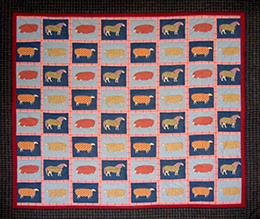Quilting Hoops and Quilting Frames
A quilting hoop or quilting frame makes the quilting of large projects (e.g. bed-sized quilts) very easy. They come in a variety of shapes, styles and sizes, ranging from small wooden handheld quilting hoops to room size quilting frames for large sized hoops.
The hoop or frame works by stretching the quilt sandwich out keeping the top, batting and backing in place so they quilter can sew in a neat and delicate manner without worrying about the quilt losing shape. The taunt quilt is then easier to work on allowing the quilter to use the tiniest stitches should they so desire.
Quilting frames are generally four sided and can be self supporting. They are large in size and can be quilt bulky. They are great for very large quilts.
Quilting hoops are obviously round (like a hoop!) and consist of two round pieces, with one slightly smaller than the other so that it fits inside the other. Quilting hoops are generally made of word or sturdy plastic and differ to embroidery hoops as they are a little deeper in order to support the three layers of a quilt sandwich which can often be quite bulky.
Quilters do not need to use a quilting frame if they are quilting a smaller piece however it would help them getter a more beautiful finish on their final quilt. When creating a large quilt even a 14-18 inch hoop is adequate and will provide good strong support for hand quilting.
How to use a quilting hoop
To use the quilting hoop (or frame), first get the smaller hoop (this will be a complete circle without a butterfly wing nut attached) underneath the area that you want to quilt and then place the larger hoop (the piece with the butterfly wing nut) over the top. This should cause the quilt sandwich to become taunt as you push the top hoop down over the bottom hoop with the quilt in between.
Once the hoops are over the top of each other and the quilt sandwich is taunt and does not sag in the middle, tighten the wing nut until the hoop is secure and closed. Then you can start quilting. Move around and try and always work in the centre of the hoop, rather than near the edges.

